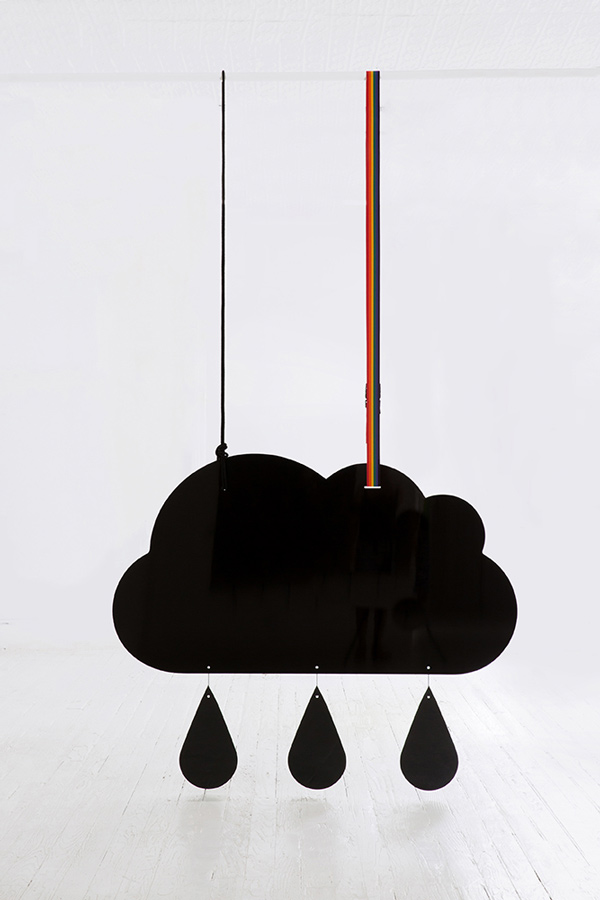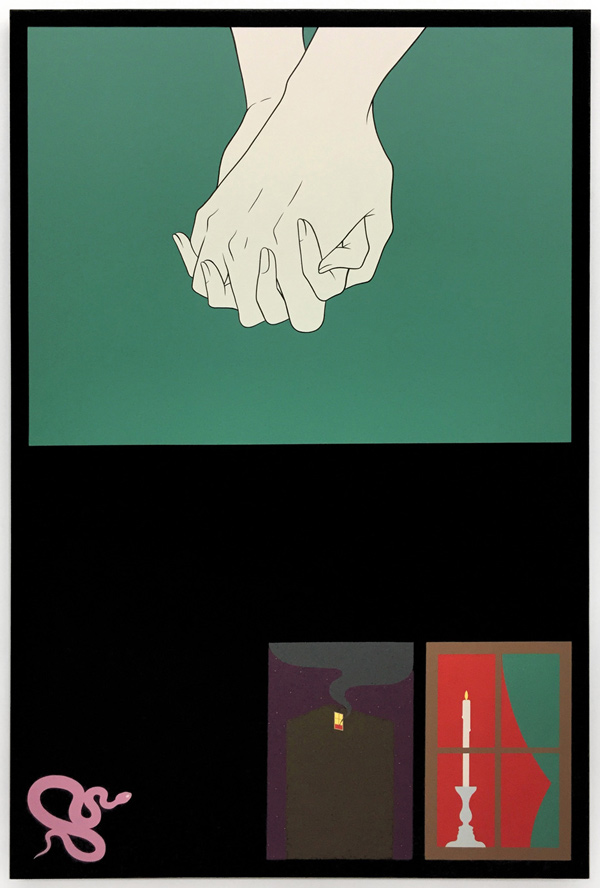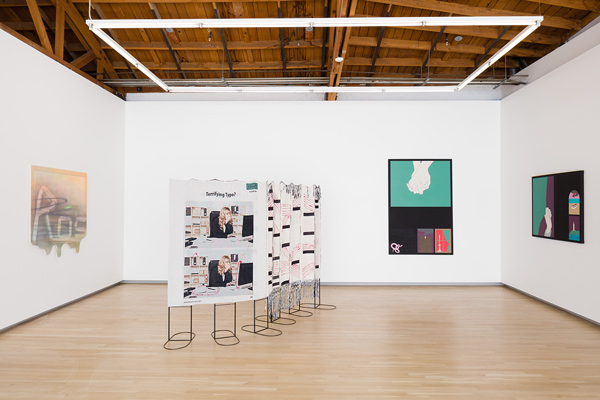A black rain cloud hangs at the doorstep of Shulamit Nazarian’s compelling group show, “Broken Language.” The rain cloud—No Pressure (2016) by Wendy White—is a flat, aluminum-composite cartoon of a cloud that hovers at waist-height from the ceiling by nylon rope and rainbow webbing. White’s caricature of a cloud seizes hold of a mood—simultaneously ominous and banal—that runs through each of the four artists’ work throughout the show.

Wendy White, No Pressure, 2016, Courtesy of the Artist and Shulamit Nazarian, Los Angeles
Accompanying White’s high-gloss, Dibond raincloud are her paintings: airbrushed and adorned with the brand names of ski and alpine equipment manufacturers. These paintings of crisp logos superimposed on abstract color fields echo Ed Ruscha’s cross-pollination of high art painting with the visual tropes of a billboard. Both White and Ruscha’s paintings combine airy, ephemeral spaces with flat word-inscribed screens. White’s paintings differ in their incorporation of letter forms and decals that extend beyond the picture plane. In Rossignol/Elan (2015), the painting itself seems to drip down the wall.

Greg Ito, Casual Encounter, 2017, Courtesy of the Artist and Shulamit Nazarian, Los Angeles
Flatness continues across the gallery in Greg Ito’s acrylic paintings depicting various combinations of comic-like illustrations. Individually, Ito’s paintings, with their cold surfaces and uniform graphics, are like a deadpan communiqué a la airline safety brochures. In totality, the paintings induce a feeling of isolation or imminent dread. In The Watcher (2017), Ito combines three images: a hand that pulls at fabric, a beached and abandoned rowboat, and a lighthouse on a promontory. Ito’s paintings, foreboding despite their flatness, are akin to Roy Lichtenstein’s work from the 1960s. They both present the illusion of space as well as the fact of surface using emotionally charged images.

Takeshi Murata, Jogger (Red), 2014, Courtesy of the Artist and Salon 94, New York
Takeshi Murata also collapses spatial depth and material flatness using computer generated graphics to create digitized still lifes. In Jogger (Red) (2014), Murata creates a trompe l’oeil of a glass and mirrored cube that seems to jut from the wall with smiley-face stickers on the outside and the Kool-Aid man refracted on the inside. What is in fact a pigment print within an aluminum frame, the work plays tricks on the eye using the sickly saccharine imagery of upbeat advertising. Jogger reflects these distorted smiley faces back at the viewer in a way that quickly becomes difficult to look at.

Josh Faught, Attachments, 2016, Courtesy of the Artist and Shulamit Nazarian, Los Angeles
White, Ito, and Murata’s reliance on corporate signs, icons and illustrations hearken back to the birth of American Pop Art in the 1960s. Josh Faught, the fourth artist, does a sort of short circuit of these codes and symbols. Whereas Murata reflects a distorted smiley face, Faught pins a smiley-face button directly onto the hemp and stretched linen surface of Attachments (2016), along with a laminated advertisement for a chiropractor, cheap gas-station sunglasses, and a campy greeting card. His textiles and sculptures are a collage of the detritus of self-help declarations (such as a button that says “LOOK OUT WORLD”) and various digital pictograms, like an early ’90s Microsoft clip-art version of a pencil woven directly into Attachments’s surface. Faught conjoins the imagery of endless reproductibility with the craft and uniqueness of hand-dyed fabrics.
“Broken Language,” ostensibly inspired by the rise of emoji usage, but the artworks have underpinnings in Pop Art and the movement’s corresponding skepticism of a mode of seeing in which everything seems subject to digital processing and manipulation. The exhibiton exemplifies language and mass communication’s endless mutability and capacity for surprise. It also pays close attention to the feeling of disconnection and anxiety that occur when human connection is warped and monetized through commercial advertising or fitted within prepackaged icons and symbols.
Broken Language at Shulamit Nazarian, on view until July 1, 2017.


